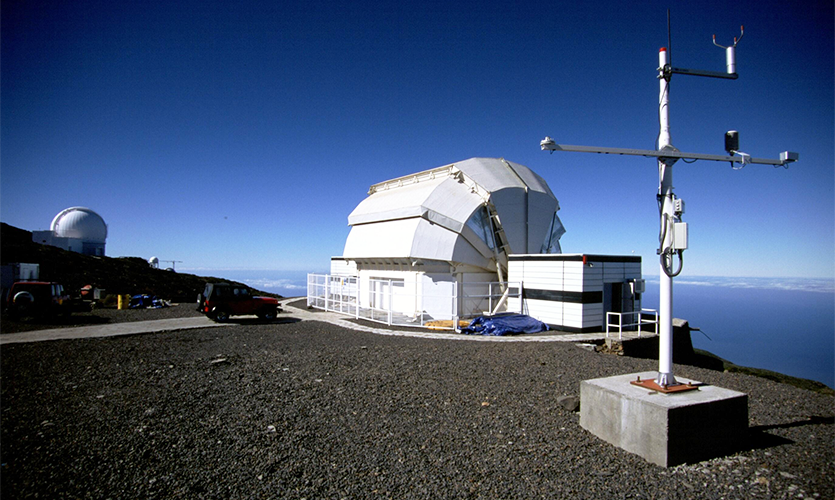LJMU researcher plays pivotal role in unexplained cosmic flare

An LJMU astronomy researcher has played an integral role in the investigation of one of the most observed and puzzling objects ever discovered.
The comprehensive observations of Daniel Perley, Assistant Professor of Astronomy and Co-investigator of the GROWTH (Global Relay of Observatories Watching Transients Happen) team of astronomers, shed light on what may have happened when there was an initially unremarkable cosmic flare on a summer night last June.
The flare was first registered in the ATLAS survey designed to look for transients - flashes in the sky that carry signals from violent cosmic explosions such as supernovae, merging neutron stars and stars being eaten by a black hole.
Assigned the computer-generated catalog name AT2018cow, and immediately nicknamed the ‘Cow’, this cosmic event quickly attracted the attention of astronomers around the world, including Assistant Professor Perley.
He commented: “This was an incredibly luminous event, brighter than almost any supernova we've ever seen before. The Cow also appeared and faded away very quickly - so quickly that existing supernova models can't properly explain it. It must be a new type of extremely energetic, explosive event.”
Assistant Professor Perley employed many of the optical telescopes in the GROWTH global network of observatories to closely follow up the object for more than a month after detection. The rich dataset revealed that the material ejected after the explosion was expanding at very high speeds. This may have contributed to the very rapid brightening of the object, which reached peak brightness in just two days rather than weeks, which is more common for known types of supernovae.
As optical astronomers in GROWTH were keeping their telescopes on the Cow, Anna Ho, a GROWTH PhD student at Caltech, was observing it with the Submillimeter Array (SMA) in Hawaii and the Atacama Large Millimeter Array (ALMA) in Chile.
Anna said: “This object is brighter than any supernova in millimeter waves. Our radio data revealed that a shock wave is traveling outward from the explosion at one-tenth the speed of light.”
At later times, as the Cow was fading, the GROWTH team observed subtle bumps and wiggles in the optical data rather than the smooth decline in brightness that is more typical for supernovae. According to Assistant Professor Perley, this suggests that there is an additional source of power or ‘central engine’ that keeps pumping energy into the expanding material.
Meanwhile, Anna combined her radio data with publicly available X-ray data from NASA’s NuSTAR and Swift missions and arrived at the same conclusion - the Cow was an ‘engine-driven’ explosion, continuously energized by either a black hole or a fast-spinning neutron star formed in a supernova, known as a magnetar.
Anna added: “This is the first time any transient has been seen to increase in brightness in millimeter waves. Normally by the time explosions are observed with a millimeter telescope, they are already fading in brightness.”
Six months after the Cow was first spotted, astronomers continue to debate what it is and how it really happened. The most favored interpretation supported by the GROWTH team, is that the Cow is an exotic type of supernova that left behind a magnetar central engine. Other teams suggest that a black hole ripping apart a type of star called a white dwarf may have instead caused it.
Assistant Professor Perley commented: “The properties of the Cow strain nearly all models we have tried to devise to explain it. Whatever it is, it must involve some form of energetic and very fast explosion interacting with an extremely dense shell of material very close to the explosion progenitor.”
Due to his work on the Cow, Assistant Professor Perley was part of a press panel at the 233rd meeting of the American Astronomical Society in Seattle, which presented the latest results on the Cow by various groups.
The study led by Assistant Professor Perley, entitled ‘The Fast, Luminous Ultraviolet Transient AT2018cow: Extreme Supernova, or Disruption of a Star by an Intermediate-Mass Black Hole?’ has been accepted for publication in the Monthly Notices of the Royal Astronomical Society.
GROWTH is an NSF funded project, led by Caltech with 16 international partners that conducts frontier research in time domain astronomy. To learn more, visit http://growth.caltech.edu

Astronomers using ground-based observatories caught the progression of a cosmic event nicknamed the ‘Cow’ as seen in these three images.
Left: The Sloan Digital Sky Survey in New Mexico observed the host galaxy Z137-068 in 2003, with the Cow nowhere in sight. (The green circle indicates the location where the Cow eventually appeared).
Centre: The Liverpool Telescope saw the Cow very close to the event’s peak brightness on June 20, 2018.
Right: William Herschel Telescope took a high-resolution image of the Cow nearly a month after it reached peak brightness, as it faded and the host galaxy came back into view.


